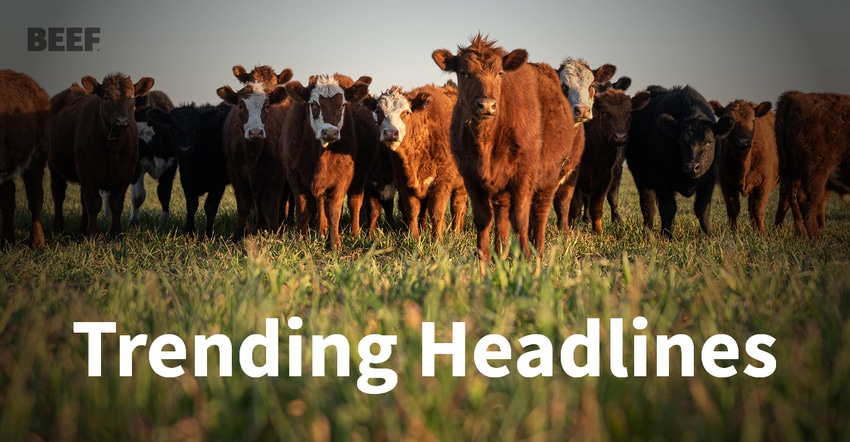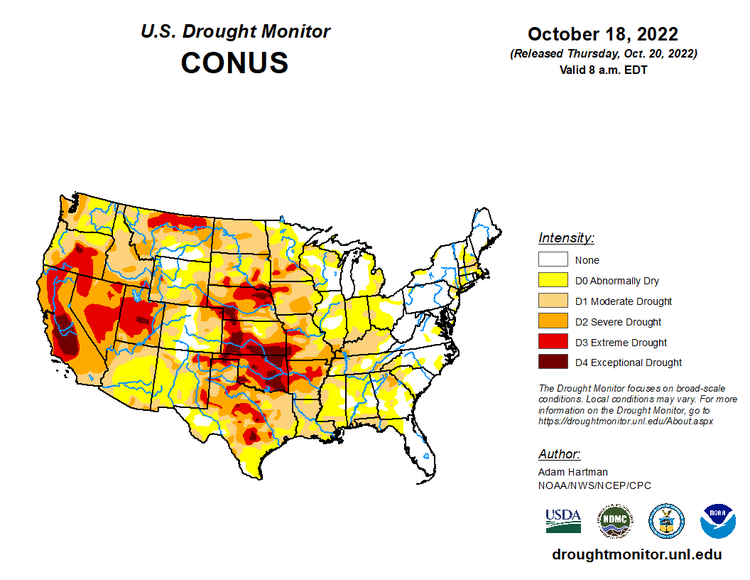5 Trending headlines in the beef world - Oct 25, 2022
Here’s a look at 5 headlines that you don’t want to miss.

Let’s take a look at 5 headlines involving cattle from across the USA. From Oklahoma ranchers having to deal with problems other than the drought to Florida farmers finding the total of Hurricane Ian to be a lot for producers.
1. Last week’s drought map did not bring good news. The map showed how drought conditions were worsening in the middle of the country and spreading eastward.
There appears to be good news this week. The Oklahoma region and into Missouri appears it will get some needed rainfall. Albeit, probably too much, too quick, inches of rainfall are expected from a weather system coming out of the Rockies this week.

2. Hurricane Ian caused as much as $1.8 billion in damages to Florida agriculture last month, state agriculture officials said. The Category 4 storm caused between $1.1 billion and $1.8 billion in losses to the state's crops and agriculture infrastructure when it tore through the peninsula after landing in southwest Florida, according to a preliminary estimate released Monday by the Florida Department of Agriculture and Consumer Services. Crop damage ranged from $686 million to $1.2 billion. The biggest losses came from citrus which had damages between $416 million and $675 million, the Department of Agriculture report said.
3. It was a long weekend for fire crews in Rogers County as they battled a several hundred-acre grass fire just a few miles east of Chelsea. That fire is now being investigated as arson, and local ranchers said this fire has left many worried about how they’ll get by. That wasn’t the only grass fire. It’s the second in as many weeks within miles from one another. The bigger problem than the grass burned was the round bales at both properties. Over 300 round bales were burned between the two fires and ranchers are concerned how to pay for the feed they need for the cattle due to the drought.
4. A decline in Brazilian cattle prices this year and strong demand for the country's beef exports will widen Brazilian meatpackers' margins in the short term, according to analysts, though weakness in the domestic market could undercut those gains. Brazil is home to some of the world's biggest meatpackers, including JBS SA (JBSS3.SA), Marfrig (MRFG3.SA) and Minerva SA (BEEF3.SA).
Beef prices in Brazil have been dropping on the back of a higher number of cattle coming to market as well as the more aggressive negotiating stances adopted by foreign buyers, especially China.
A weaker yuan currency has pushed China, which accounted for almost 53% of Brazilian beef purchases in September, to press for discounts from sellers in the South American nation, Safras & Mercado analyst Fernando Iglesias said.
About 30% of Brazil's beef production is sent abroad, with the rest consumed at home. But high inflation in the country has cut into consumers' purchasing power, weakening domestic demand for beef and pushing companies to look to export markets.
Brazil's beef exports in October have already surpassed those from the same month in 2021, according to government data.
5. Patrick Keyser, a researcher at the University of Tennessee, Knoxville is the lead author of a new study that assessed the strengths and weaknesses of five warm-season forage grasses. The study was published in Agronomy Journal.
Keyser and colleagues measured the nutritional value of different warm-season grasses. Three of the warm-season grasses evaluated in the study—eastern gamagrass, switchgrass, and a mix of big bluestem and indiangrass—were native grasses.
The native options may be less familiar to many beef producers in the eastern and southeastern U.S.,but ended up being the most economically efficient.
And the study showed that the native forage options had an unexpected benefit. Tall fescue often harbors a kind of fungus. This fungus lives in cooperation with the grass but can produce chemicals that are toxic to cattle. Warm-season grasses do not harbor this fungus.
All five warm-season grasses would reduce the risks associated with tall fescue toxicity. But the three native options would allow producers to move cattle off tall fescue up to 29 days sooner in spring than bermudagrass.
The team also monitored the weight gain of heifers eating the variety of grasses.
For example, for cattle producers aiming for cattle to gain weight quickly—important for grass finishing—a combination of big bluestem and indiangrass would be the best forage option. On the other hand, for producers looking for sustained weight gain over the summer months, switchgrass was a better option.
Using heifers for the study allowed the researchers to rigorously assess different warm-season grasses.
About the Author(s)
You May Also Like


.png?width=300&auto=webp&quality=80&disable=upscale)
